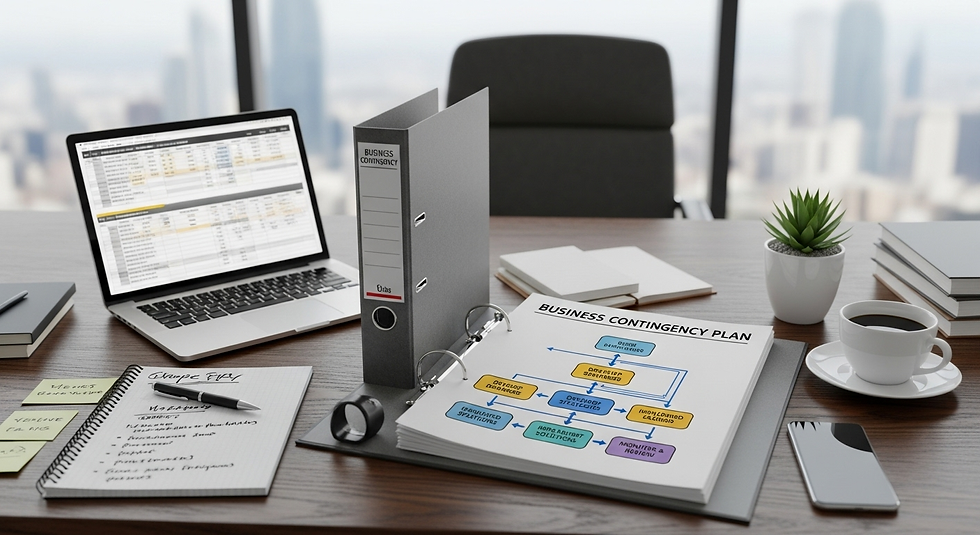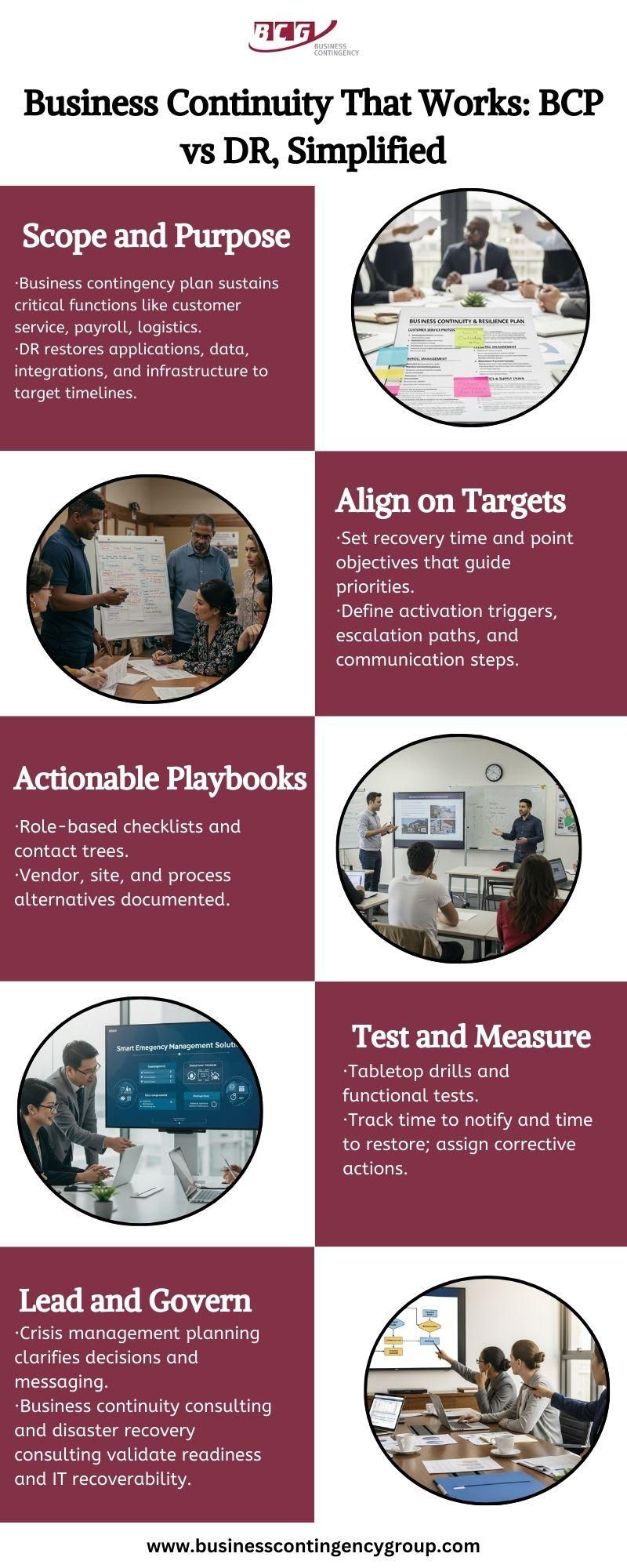Business Contingency Plan: A Modern Playbook for Real-World Resilience
- rebekahh84
- Sep 24
- 3 min read
Updated: Sep 25

Growth strategies often assume smooth conditions, yet disruption is the rule, not the exception. A robust business contingency plan equips leaders to keep operations moving when incidents strike, whether the trigger is a cyber incident, utility failure, extreme weather, supplier breakdown, or sudden workforce unavailability. Rather than a shelf document, think of it as a living operating system for continuity that clarifies decision rights, recovery priorities, and communication pathways.
This guide reframes traditional planning with pragmatic steps, credible governance, and measurable recovery targets, while integrating crisis management planning, disaster recovery consulting, and business continuity consulting into one cohesive approach.
Business Contingency Plan vs Disaster Recovery Plan: Same Goal, Different Focus
A business contingency plan and a disaster recovery plan share the goal of restoring stability but cover distinct scopes. The BCP keeps essential functions running during and after disruption by aligning people, processes, technology, facilities and suppliers around clear roles and contingencies. DR focuses on restoring IT services and data to meet recovery targets. Treat DR as a critical component within broader business contingency and not a parallel track.
When recovery time objective and recovery point objective drive both plans, handoffs are cleaner and restoration aligns to what the business actually needs.
Key Distinctions to Anchor:
Business Contingency: Enterprise wide continuity of critical functions from payroll and customer service to logistics and vendor coordination.
Disaster Recovery Plan: Restoration of applications, data, integrations, and infrastructure to agreed recovery windows.
Crisis Management Planning: Leadership structure and comms that activate, decide, and coordinate across the enterprise.
Building Blocks: From Risk Mapping to Tested Playbooks
A strong business contingency plan moves from analysis to action with clarity and focus.
Analyze What Matters
Run a concise business impact analysis to map critical processes, dependencies, and acceptable downtime.
Define RTO and RPO that the business can support with current staffing, budget, and tooling.

Design Strategies That Fit Reality
Create alternatives for sites, vendors, and logistics; confirm manual workarounds; validate data protection and application failover.
Align crisis management planning with activation triggers, decision thresholds, spokespersons, and stakeholder messages.
Turn Strategy into Muscle Memory
Write short, role based playbooks and quick reference guides.
Schedule tabletop exercises and functional tests; track time to notify, time to restore, and successful handoffs.
Tighten with Evidence
Log corrective actions with owners and deadlines.
Refresh the contingency plan after each drill or incident and at planned intervals.
Technology and Expertise: Right-Sizing for Outcomes
Tools and advisors should serve the plan, not the other way around.
Business Continuity Software for Small Businesses
Prioritize essentials - version control, role based access, notification workflows, exercise scheduling, vendor dependency registers and audit trails.
Avoid feature bloat; aim for adoption, speed and clarity.
Validate backup integrity, failover paths, runbook steps, and restoration sequencing against business defined recovery targets.
Test integration points and data consistency across critical systems including third-party platforms.
Business Continuity Consulting
Establish governance, metrics, and reviews that keep the program current.
Harmonize policies, training, and testing across departments to reduce friction and duplication.
Tie-In with Emergency Response
Integrate safety actions, facility procedures, and initial incident stabilization with the continuity and DR playbooks to eliminate confusion at activation.

Implementation Path: 90 Days to Momentum, 12 Months to Maturity
Progress beats perfection. Use phased, outcome-driven milestones.
First 90 days:
Identify top 10 critical processes and define RTO/RPO.
Publish activation criteria, roles, and a one-page incident communication plan.
Conduct one tabletop exercise and assign corrective actions.
Months 4 to 12:
Expand exercises to include cross-functional teams and key suppliers.
Instrument KPIs: time to notify, time to assemble, time to restore, and user-ready status.
Automate alerts, centralize plan versions, and embed lessons learned into playbooks within two weeks of each test.

Conclusion: Practical Resilience, Delivered
A business contingency plan works when it is simple to activate tied to measurable targets, and reinforced through evidence-based drills. Programs that connect crisis management planning, disaster recovery consulting, and business continuity consulting turn plans into practiced behaviors and reduce both downtime and risk.
Business Contingency Group brings a pragmatic, metrics-first approach to help organizations design, test, and evolve continuity programs that hold up under pressure. From right-sized tooling to cross-functional exercises, Business Contingency Group tailors guidance to the way teams actually work, accelerating readiness without unnecessary complexity.
Contact the experts at Business Contingency Group today and get a tailored business contingency plan!
FAQs
1. What is the first step in creating a business contingency plan?
Start with a focused business impact analysis to identify critical processes, dependencies, and acceptable downtime, then set realistic RTO and RPO.
2. How often should contingency and DR plans be tested?
Run awareness training annually, role-based refreshers semiannually, and exercises at least quarterly for critical functions or after major changes.
3. How do crisis communications fit into continuity?
Crisis communications provide activation criteria, decision ownership, and stakeholder messaging, ensuring clarity from the first alert through stabilization and recovery.




Comments